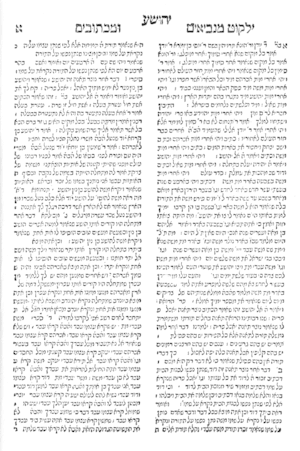 | ||
Similar Pirke De‑Rabbi Eliezer, Yalkut Yosef, Tosefta, Pirkei Avot, Me'am Lo'ez | ||
The Yalkut Shimoni (Hebrew: ילקוט שמעוני) or simply Yalkut is an aggadic compilation on the books of the Hebrew Bible. From such older haggadot as were accessible to him, the author collected various interpretations and explanations of Biblical passages, and arranged these according to the sequence of those portions of the Bible to which they referred.
Contents
Contents
The individual elucidations form an organic whole only insofar as they refer to the same Biblical passage. Lengthy citations from ancient works are often abridged or are only partially quoted, the remainder being cited elsewhere. Since the interpretations of the ancient exegetes usually referred to several passages, and since the Yalḳuṭ endeavored to quote all such explanations, repetitions were inevitable, and haggadic sayings relating to two or more sections of the Bible were often duplicated. In many instances, however, only the beginning of such an explanation is given, the reader being referred to the passage in which it is recorded in its entirety.
Order and arrangement
The work is divided into sections, which are numbered from Genesis to the end of Deuteronomy, and are numbered anew from the beginning of Joshua, the first non-Pentateuchal book, so that the Yalḳuṭ falls into two parts:
In the arrangement of the Hagiographa the author deviates from the Talmudic order (B. B. l.c.) by placing Book of Esther before Book of Daniel, while the reverse order is followed in the Talmud. The division into sections is arbitrary, and the sections are very unequal in length; Deut. 818, for example, in the Wilna edition containing only five lines, while Deut. 938 comprises eighteen columns. In his exegesis of each passage, often in the text itself, the author indicates the sources from which his explanations are derived. In the Salonica edition they are given at the beginning of each corresponding Biblical passage, although in later editions they were placed in the margin. In many instances, however, the sources are given in an inconvenient place or are entirely eliminated, while some references are even indicated by a later redactor, as, for example, Job 921, where the source (Ex. R.) is a later addition, the original redactor being unacquainted with Exodus Rabbah (comp. A. Epstein, Rabbi Shimeon Ḳara weha-Yalḳuṭ Shim'oni, in Ha-Ḥoḳer, i. 137).
Author and date
The author of the Yalḳuṭ can not be determined with certainty. The title-page of the Venice edition ascribes the composition of the work to R. Simeon of Frankfort, "the chief of exegetes" ("rosh ha-darshanim"), and this was accepted by David Conforte and Azulai, who called him Simeon Ashkenazi of Frankfort. J.L. Rapoport (in Kerem Ḥemed, vii. 7 et seq.), on the other hand, maintained that R. Simeon (the father of R. Joseph Ḳara), who flourished in the 11th century, was its author, but this assertion is untenable since the compiler of the Yalḳuṭ used midrashim of a later date. If the Yalḳuṭ was so old, moreover, it would be difficult to explain why no mention of it is made by R. Nathan b. Jehiel, the author of the Aruk, or by Rashi.
A. Epstein inclines to agree with Zunz that the author of the Yalḳuṭ flourished in the early part of the 13th century. According to Zunz, the work was written by R. Simeon Ḳara, who lived in southern Germany at that period, and the title "ha-Darshan" was bestowed upon him probably at a later date. It is certain that a manuscript of the Yalḳuṭ, mentioned by Azariah dei Rossi, existed in 1310 (comp. Zunz, G. V. pp. 295–303); but despite this, there is scarcely any allusion to the work during the 14th and 15th centuries. This may be ascribed, however, to the unhappy position of the German Jews and to the repeated persecutions of the period; for peace and prosperity were necessary for the copying of so extensive a work, and the Jews of Germany had neither. After the beginning of the 15th century, on the other hand, the work must have been disseminated in foreign countries, for it was used by Spanish scholars of the latter half of that century, Isaac Abravanel being the first to mention it (comp. A. Epstein, l.c. p. 134).
Older editions
The editio princeps of the Yalḳuṭ was printed in Salonica in 1521, the latter part of the work, relating to the Prophets and the Hagiographa, appearing first. The part treating of the Pentateuch appeared between 1526 and 1527, and the entire work was later published in Venice (1566) with certain emendations and deviations from the Salonica edition. All later texts are merely reprints of the Venetian edition, with the exception of one published at Livorno (1650–59), which contained additions and corrections as well as a commentary by R. Abraham Gedaliah. The latest text prior to 1900 (Wilna, 1898) is based on the editions of Lublin, Venice, and Livorno, and contains footnotes giving the sources, a glossary of difficult words, and an index of the chapters and verses of Biblical passages. To this edition is appended a brief commentary by Abraham Abele Gumbiner of Kalisz entitled Zayit Ra'anan.
